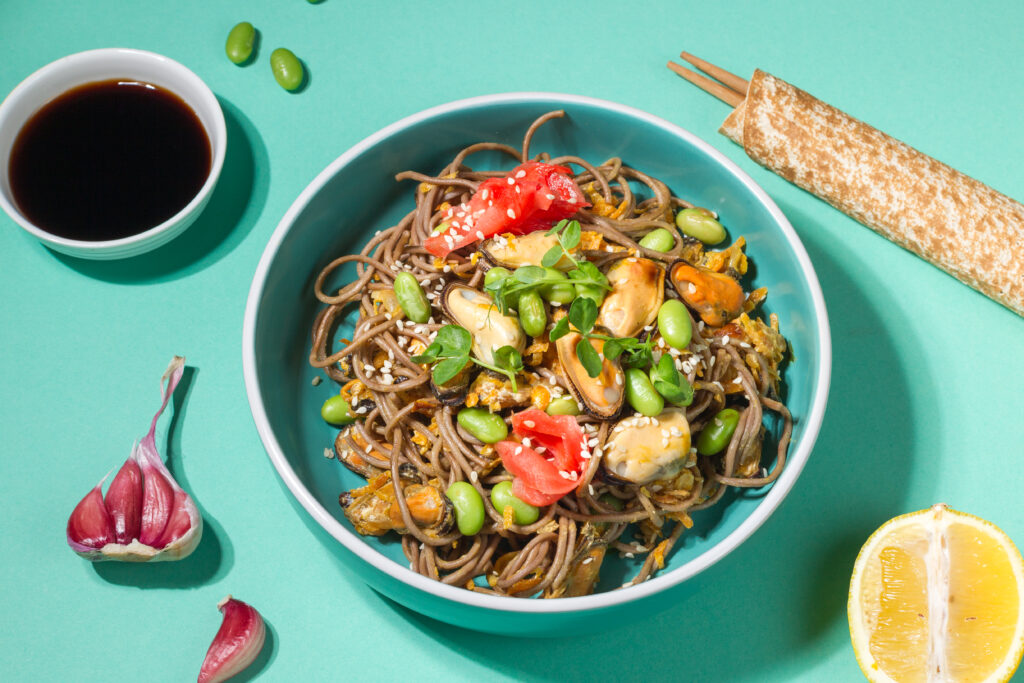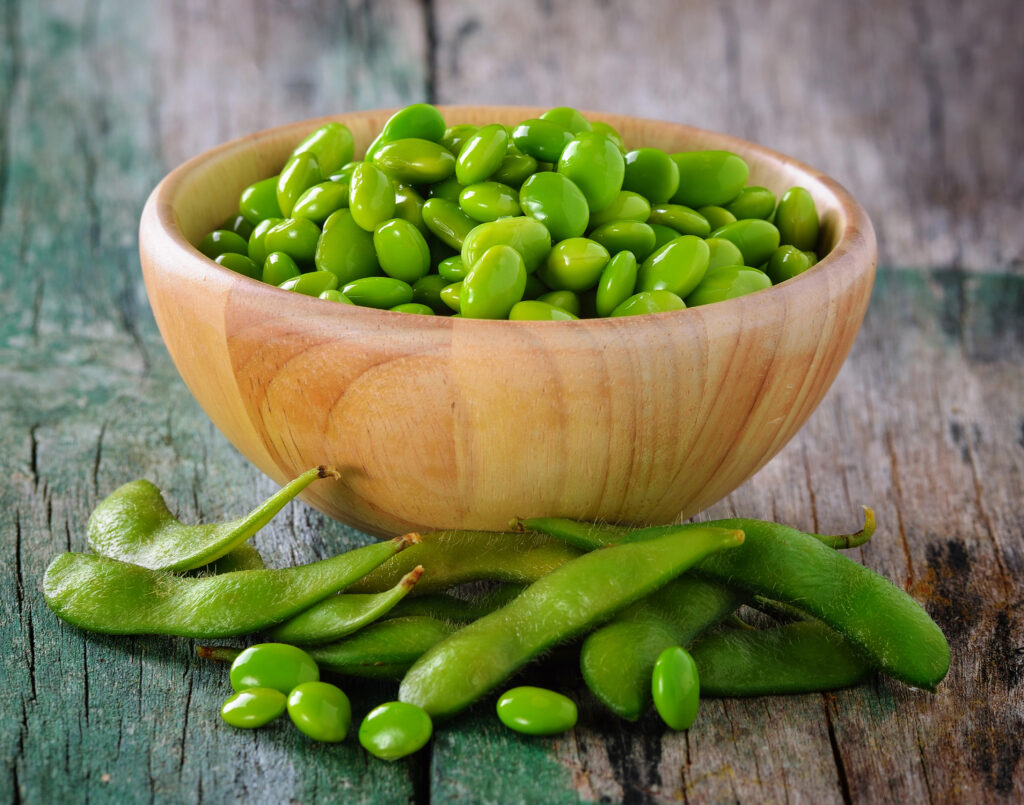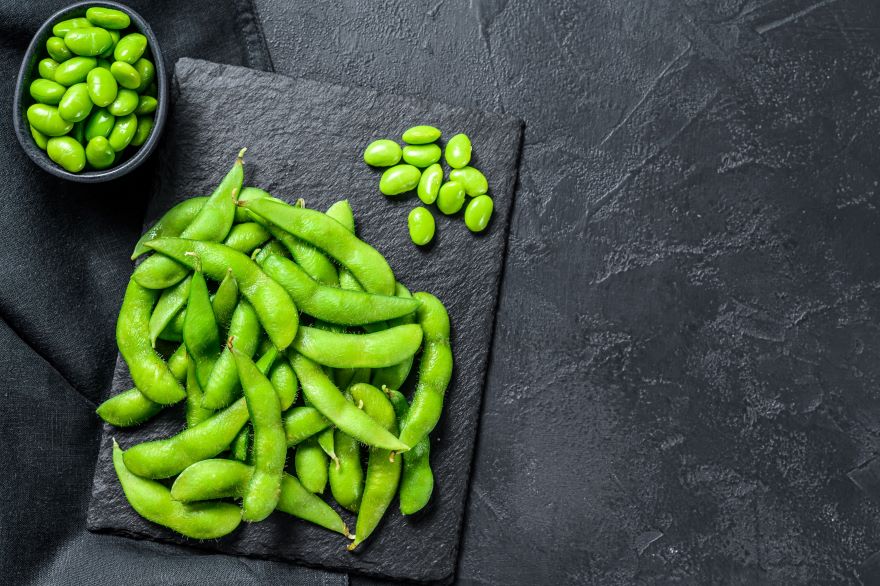I never imagined that a simple green bean could transform my family’s life. It started one evening at our dinner table, when I decided to try something new. The curious looks on Bruce and James’s faces as they poked at these bright green pods still make me smile. Now, five years later, edamame isn’t just food for us—it’s part of our family story. And for those wondering, yes, edamame is naturally gluten-free! It’s amazing how one small discovery can open up a whole new world of healthy eating adventures.

Our Journey Begins
“Mom, what are these green beans?” my son James asked, poking at the steaming bowl of edamame I’d placed on our dinner table. It was 2019, and I’d just started exploring new healthy options for our family meals. My husband Bruce had been trying to eat more nutritiously, which had inspired me to experiment with different ingredients and cooking styles. The change in our eating habits felt like a small challenge at first, and I was constantly searching for wholesome alternatives to our usual dishes.
Bruce looked skeptically at the pods, but being the supportive partner he is, he picked one up and tried it. His eyes lit up. “These are good! They’ve got a really nice flavor.”
That moment marked the beginning of our family’s love affair with edamame. What started as a simple alternative became a staple in our kitchen, leading us to discover its incredible versatility and health benefits.
The Power of Edamame
Since incorporating edamame into our meals, we’ve noticed remarkable changes. Bruce’s energy levels have soared, and he doesn’t get the afternoon slumps anymore. James’s baseball coach actually asked what we changed in his diet—the protein helps with his muscle recovery after practice. As someone trying to maintain a healthy weight, I love that edamame keeps me satisfied without excessive calories.
Let me share some numbers that amazed me. In one cup of edamame, you get
- 18.4 grams of protein
- 8 grams of fiber
- Only 188 calories
- 120% of daily folate needs
- 20% of daily iron needs
The nutrients in edamame have become valuable additions to our family’s diet. Bruce’s iron levels have been great, and his doctor was particularly impressed with his cholesterol levels at his last checkup, attributing the improvement partly to our increased edamame consumption.
Getting Started with Edamame
Basic Preparation
Start simple! Steam the pods for 5 minutes, sprinkle with sea salt, and squeeze the beans out to eat. That’s how we started, and it’s still one of our favorite ways to enjoy edamame. The interactive nature of popping the beans from their pods makes it fun for the whole family.
Storage Tips
- Keep frozen edamame in airtight containers.
- Fresh edamame lasts 3-5 days in the fridge.
- Cooked edamame stays good for 3 days refrigerated.
- Buy frozen in bulk during sales.
- Compare prices between Asian markets and regular grocery stores.
For those serious about their edamame journey, investing in proper storage and preparation equipment makes all the difference. The Zwilling Fresh & Save Vacuum Sealer Machine Starter Set has transformed how we store our edamame, both from the store and our garden. This premium vacuum sealing system helps preserve freshness, making bulk shopping more practical and helping us save money in the long run. We use it to store our garden harvest too, keeping that farm-fresh taste locked in for months.
- SET INCLUDES: 1 large vacuum food storage container, 2 small and 2 medium vacuum sealer bags for food, 1 rechargeable vacuum sealer machine
- SAVE TIME AND MONEY: Keeps food fresh up to five times longer than non-vacuum storage methods
- EASY MEAL PREP: The easy-zip closure makes meal prep simple so you can save time and make healthy choices.
- TAKE YOUR FAVORITE SNACKS EVERYWHERE: These reusable snack bags are perfect for every occasion. Pack them with your favorite snack for school, work, or even at the pool.
- CONVENIENT: Reusable, resealable food storage bags feature easy-zip closures to create a perfect seal and are freezer safe, and microwave safe (without vacuum seal).
Our Backyard Bean Adventure
Our love for edamame eventually led me to an exciting discovery—we could grow our own! Looking at our grocery bills one day, I noticed how much we spent on store-bought edamame at the supermarket. That’s when I spotted the unused small lot behind our house. “Why not try growing our own?” I thought.
The journey from consumer to producer was both challenging and rewarding. I started by preparing the soil in our modest plot, researching the best growing conditions for soybeans. Bruce helped me install a simple irrigation system, and James became our enthusiastic “bean monitor,” checking the plants’ progress daily.
Our first harvest was modest, but there’s something magical about eating beans you’ve grown yourself. The fresh edamame had a sweetness and texture that even our favorite frozen brands couldn’t match. Now, during the growing season, we supplement our store-bought supply with home-grown edamame, and the small lot that once sat unused has become our family’s favorite garden project.
Tips for Aspiring Edamame Gardeners
- Start small with a few plants.
- Ensure good drainage.
- Plant after the last frost
- Keep soil consistently moist.
- Harvest when pods are bright green and plump.
Our Family’s Favorite Recipes
1. Family-Favorite Edamame Hummus
This recipe came about when James returned from baseball practice starving, and Bruce was avoiding his usual wheat crackers and dip. The result became an instant family favorite.
Recipe:
- 2 cups shelled edamame, steamed
- 2 cloves garlic
- 3 tablespoons olive oil
- Juice of one lemon
- Salt and pepper to taste
- Water for consistency
Steam the edamame until tender, blend everything in a food processor, and watch it disappear! James loves having this for lunch, and Bruce enjoys it with crackers.
2. Power-Packed Edamame Rice Bowl
Perfect for busy weeknights, this recipe came about during Bruce’s recovery period when he needed extra protein and nutrients.
Recipe:
- 1 cup brown rice
- 2 cups steamed edamame in pods
- Sliced avocado
- Sesame seeds
- Sea salt
- Optional: gluten-free tamari

3. Crispy Roasted Edamame Snack
James invented this one when he wanted something crunchy to replace his old snacks.
Recipe:
- 2 cups shelled edamame
- 1 tablespoon olive oil
- Your favorite seasonings (we use garlic powder and sea salt)
Roast at 375°F for 30-40 minutes until crispy, stirring halfway through for even cooking
The edamame needs to be shelled (removed from pods) before roasting, and this will create a crunchy snack when roasted with oil and seasonings.
4. Edamame Garden Pasta Salad
This refreshing dish became a hit during our summer picnics and backyard gatherings.
Recipe:
- 2 cups cooked pasta
- 1 cup shelled edamame, steamed
- 1 cup cherry tomatoes, halved
- 1/2 cup cucumber, diced
- 1/4 cup red onion, finely chopped
- 3 tablespoons olive oil
- 2 tablespoons fresh lemon juice
- Fresh basil leaves, chopped
- Salt and pepper to taste
Mix all ingredients in a large bowl and chill for at least 30 minutes to let the flavors blend. It’s become our go-to dish for warm evenings, with Bruce often commenting that it’s the perfect light dinner.
Preparing edamame becomes effortless with the right tools. The Instant Pot Pro 10-in-1 Pressure Cooker has become indispensable in our kitchen for perfectly steamed edamame every time. Its precise temperature control and steaming function deliver consistently tender beans, while the large capacity means we can prepare enough for our weekly meal prep or family gatherings.
- 10-IN-1 FUNCTIONALITY: Pressure cook, slow cook, sous vide, sauté pan, sterilizer, yogurt maker, food warmer, cake baker and steamer
- CUSTOMIZABLE COOKING PROGRAMS: The included 28 program settings are perfect for a selection of essential meals
- CONVENIENT FAVORITES: 5 programmable settings for your own special recipes
- FAST OR SLOW: Pressure cook to save time and retain more flavor, or slow cook for traditional recipes
- 11+ PROVEN SAFETY FEATURES: Overheat Protection, safe locking lid, upgraded gentle steam release switch with diffusing cover to reduce noise and prevent splashing on the counter, and more
Seasonal Favorites

Our edamame journey has evolved with the seasons:
Spring: This is when we prepare our garden beds and plant our edamame seeds. Meanwhile, we mix fresh herbs from our garden with store-bought edamame for light, refreshing salads. The anticipation of watching our plants grow adds an extra layer of joy to our meals.
Summer: Besides making edamame pasta salad for picnics and James’s baseball team snacks, we eagerly await our garden’s harvest. Nothing beats the taste of freshly picked edamame, steamed within hours of harvesting. The kids in the neighborhood often stop by to help harvest and learn about growing their own food.
Fall: Bruce’s butternut squash and edamame soup is our pre-trick-or-treating tradition, and we process and freeze our final garden harvest to enjoy through winter. Our holiday parties now always feature our famous spinach-edamame dip, which has converted many skeptics into edamame enthusiasts.
Winter: While our garden rests, we add our frozen homegrown edamame to warming stir-fries and rice bowls, perfect for cold evenings. This is also when we plan next year’s garden, often ordering seeds early and dreaming of spring planting.
Learning from Kitchen Adventures
Not every experiment has been a success! The “Great Edamame Burger Disaster of 2020” taught us valuable lessons. After watching my veggie burgers completely fall apart on the grill, we developed our foolproof recipe:
The Actually Stays Together Edamame Burger
- 1 cup shelled edamame
- 1 cup chickpeas
- 1/2 cup cooked rice
- 1 egg
- Seasonings of choice
- Gluten-free breadcrumbs
The secret? Processing the edamame and chickpeas separately before combining.
Seapoint Farms Dry Roasted Edamame with Sea Salt is a protein-packed, crunchy snack that’s perfect for healthy munching and creative cooking adventures. These gluten-free, non-GMO edamame beans come in convenient 4 oz bags and offer a versatile pantry staple that can transform from snack to cooking ingredient in an instant.
- High-Protein All-Natural Vegan: Our edamame is dried and processed to preserve its nutrients and has 14g of protein per serving. Naturally gluten-free, low in calories, vegan, non-gmo, and an excellent source of protein, fiber, potassium and iron.
- Flavor: Sea Salt (vegan) - Lightly dusted with the perfect amount of sea salt. Our crunchy Dry Roasted (never-fried) Sea Salt Edamame is non-GMO and is made with just 2 ingredients: soybeans and sea salt.
- Healthy Eating: Our Dry Roasted Edamame is perfect for healthy eating. It’s heart healthy, low in calories, high in protein, with no trans-fat or cholesterol and each serving has a good source of iron to keep you energized throughout the day.
- Great On-The-Go Snack: Our Dry Roasted Sea Salt Edamame travels great and is perfect for on-the-go snacking, traveling, hiking, working out, and all of your snacking needs.
- Perfect Culinary or Snacking Addition: Not only does our Dry Roasted Edamame taste amazing straight out of the bag, but it also works wonders as a salad topper or trail mix addition.
Making It Work for Your Family
Common questions I receive include:
“How do you cook it?” Start simple with steamed pods. The interactive eating experience makes it fun for everyone.
“Won’t my kids hate it?” Make it fun! We turned popping beans from pods into a game, and now James teaches his friends how to eat it. Getting kids involved in growing their own food has been especially effective in our experience.
“Is it expensive?” Not compared to meat, especially when bought in bulk or grown at home. We’ve actually saved about $200 monthly by replacing some meat with edamame.
Tips for success:
- Start with familiar preparations.
- Get creative with seasonings
- Keep it accessible in the freezer.
- Involve everyone in preparation.
- Consider growing your own; even a small space can yield satisfying results.
- Don’t fear failures; they often lead to the best discoveries.
Beyond Just Being Gluten-Free
What started as a search for gluten-free options turned into so much more. We discovered that edamame supports heart health, helps manage blood sugar, and might even help with bone health. Growing our own has connected us more deeply to our food and brought our family closer together through shared garden responsibilities.
Our Continuing Journey
These days, edamame is a natural part of our family meals. James proudly shares his roasted edamame with teammates and teaches them about our garden. Bruce packs the hummus for lunch, and I keep finding new ways to incorporate it into our meals. Our little backyard garden has become a conversation starter in the neighborhood, inspiring others to try growing their own food.

Final Thoughts
When I reflect on our five-year journey with edamame, I’m amazed at how one small dietary discovery has transformed our lives. What began as an experiment with healthy eating has blossomed into a family passion that spans our kitchen, our garden, and our community.
Growing our own edamame taught us patience and the joy of nurturing food from seed to harvest. It showed James the real value of food and where it comes from. For Bruce, it sparked a passion for healthy eating and new culinary adventures. For me, it opened doors to creativity in cooking and gardening I never knew I had.
The impact has rippled beyond our family. Our neighbors now stop by for gardening advice, and friends regularly request our recipes. We’ve created a small but growing community of edamame enthusiasts, each discovering their own ways to enjoy these versatile beans in their daily meals.
If there’s one thing I’ve learned, it’s that sometimes life’s challenges lead us to unexpected treasures. Our gluten-free journey led us to edamame, which led us to gardening, which led us to building stronger connections with our food and our community. Who knew a little green bean could do all that?
Whether you’re dealing with celiac disease, looking for healthy protein sources, or just wanting to try something new, I encourage you to give edamame a chance. Start simple, get creative, and who knows? Maybe you’ll end up like us, unable to imagine your table without these little green powerhouses.
P.S. About that time Bruce ate an entire bowl by himself during the Super Bowl… He swears it was because he was nervous about his team winning. James and I know better—those little green beans are just that addictive! 😊

*We may earn a commission for purchases made using our links. Please see our disclosure to learn more.






